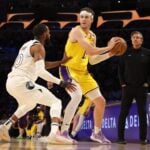
To breakdown this Wolves-Lakers playoff series, two teams featuring a mix of veteran stability and rising superstars, it’s hard to look into the head-to-head games from earlier this season. The first three contests featured an entirely different Lakers squad, one that had Anthony Davis manning the middle. Only the final, fourth matchup involved the new-look Lakers, but this time, the Wolves were missing their entire starting frontcourt. With so little anecdotal evidence to draw from, instead let’s go position by position, comparing advantages and disadvantages to determine who will come out on top.
Wolves-Lakers Playoff Series Preview — Part One: The Starters
The Guards
Minnesota: Mike Conley (8.2 PTS, 2.6 REB, 4.5 AST) and Anthony Edwards (27.6 PTS, 5.7 REB, 4.5 AST)
Los Angeles: Austin Reaves (20.2 PTS, 4.5 REB, 5.8 AST) and Luka Doncic (28.2 PTS, 8.1 REB, 7.5 AST)
It’s not an overstatement to say that this series could be decided by two of these guards, Edwards and Doncic. Doncic has a little bit more playoff experience, making it all the way to the NBA Finals last spring. Meanwhile, Edwards’ run to the Western Conference Finals last year was the first time he had made it out of the first round. Their scoring numbers are pretty similar, but it’s clear from both the stats and the eye test that Doncic is a better facilitator. His 7.5 assists per game outpaces Edwards’ 4.5, but Ant-Man takes the cake in the shooting department. Edwards shot 39.5% from deep en route to an NBA-leading 320 made three-pointers this season. Doncic was close behind at 37.9% (36,8% when including time with Dallas). Whoever wins this battle of young superstars will give their squad a great chance of moving on.
At the other guard spot, Minnesota’s Conley pales in comparison to the Lakers’ Reaves. Before Doncic arrived in February, Reaves was the Lakers secondary ball-handler. His consistency gives him the edge over Conley, whose age has finally started to show. Conley started the season slow, but since February 1, has been lights out from deep, making triples at a 45.1% clip. His role is not to score, but instead to set the table for a team that can lack maturity on the court. Although he plays this role well, his impact cannot match that of Reaves. While Doncic and Edwards is a close battle, Reaves gives the Lakers the edge over Minnesota at the guard spot.
The Forwards
Minnesota: Jaden McDaniels (12.2 PTS, 5.7 REB, 2.0 AST) and Julius Randle (18.7 PTS, 7.1 REB, 4.7 AST)
Los Angeles: LeBron James (24.4 PTS, 7.8 REB, 8.2 AST) and Rui Hachimura (13.1 PTS, 5.0 REB, 1.4 AST)
King James will capture the headlines as he seeks a fifth NBA title, but Minnesota presents a unique counter at the forward position. Randle, in his first campaign with the Wolves, will take the brunt of the defensive assignment on James. This will be James’ first foray into the playoffs with Doncic at his side. If the two can share playmaking duties and get each other easy buckets, the Wolves could be in trouble. Conversely, Randle is at his best when he is drawing multiple defenders and finding open shooters. This is a big chance for Randle to turn things around. Historically, his production has fallen off a cliff in the postseason. His career true shooting percentage is a respectable 56%, but in the postseason, that number craters to 46.2%. For the Wolves to beat the Lakers in this series, Randle must improve his playoff performance.
Moving from the big names to important role players, the second forward spot features two versatile wings. Hachimura, who shoots 41.3% from deep, is crucial as a spot-up shooter for James and Doncic to find on the perimeter. McDaniels on the other hand has his impact felt on the defensive side of the ball, where the reigning All-Defensive wing will be tasked with guarding one of the Lakers three ball-handlers. As of late, McDaniels’ offense has picked up, his four highest scoring games of his career coming since January. He’s not your prototypical 3-and-D forward though, with his 33% from deep representative of that. Instead, McDaniels likes to get into the midrange and score over smaller defenders. His defensive acumen gives him the advantage over Hachimura, but Randle’s playoff failures mean James and the Lakers forwards have the advantage in this series over the Wolves.
Center
Minnesota: Rudy Gobert (12.0 PTS, 10.9 REB, 1.8 AST)
Los Angeles: Jaxson Hayes (6.8 PTS, 4.8 REB, 1.0 AST)
This is the one position in the starting lineup that Minnesota clearly dominates. Gobert, the reigning Defensive Player of the Year, is leagues above Hayes, who only began starting games in the second half of the season. Gobert finished seventh in the league in rebounds per game this year, and eighth in blocks per game. He took a step back from last season’s incredible level, but recently, his play has picked up. Since March 1, his averages jumped to 15.4 points and 12.5 rebounds. If he can command attention on the pick and roll, it will open up shots for Minnesota’s perimeter stars. Defensively, he will need to hold his own against Doncic and James, who will certainly seek the seven-footer in switches.
For Los Angeles, Hayes will attempt to mirror the production Dallas had last season in their run to the NBA Finals. Doncic tossed lob after lob to Dereck Lively and Daniel Gafford. If Hayes hopes to stay on the floor, he will need to finish those same plays. However, it seems likely that Los Angeles will quickly shift away from playing big if Hayes is struggling against Gobert, using their bench to spread the floor and draw Minnesota’s bigs away from the hoop. Simply going off of starting lineups though, this is a clear advantage for the Wolves over the Lakers.
The post Wolves-Lakers Playoff Series Preview — Part One: The Starters appeared first on Last Word On Basketball.